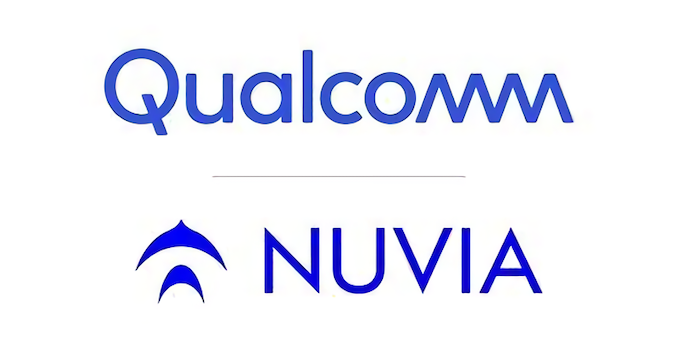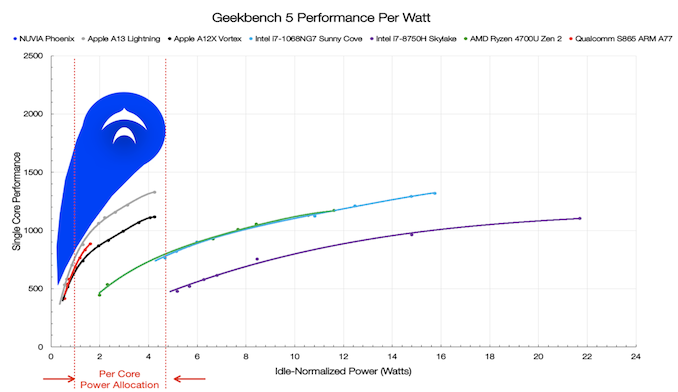Qualcomm to Acquire NUVIA: A CPU Magnitude Shift
by Andrei Frumusanu on January 13, 2021 8:30 AM EST
Today Qualcomm has announced they will be acquiring NUVIA for $1.4bn – acquiring the start-up company consisting of industry veterans which originally were behind the creation of Apple’s high-performance CPU cores. The transaction has important ramifications for Qualcomm’s future in high-performance computing both in mobile, as well as laptop segment, with a possible re-entry into the server market.
NUVIA was originally founded in February 2019 and coming out of stealth-mode in November of that year. The start-up was founded by industry veterans Gerard Williams III, John Bruno and Manu Gulati, having extensive industry experience at Google, Apple, Arm, Broadcom and AMD.
Gerard Williams III in particular was the chief architect for over a decade at Apple, having been the lead architect on all of Apple’s CPU designs up to the Lightning core in the A13 – with the newer Apple A14 and Apple M1 Firestorm cores possibly also having been in the pipeline under his direction.
NUVIA had been able to recruit a lot of top industry talent from various CPU design teams across the industry, and had planned to enter the high-performance computing and enterprise market with a new server SoC with a new CPU core dubbed “Phoenix”.
NUVIA particularly had made aggressive claims about how their design would be able to significantly outperform the competition both in raw performance and power efficiency once it came to market – usually such claims are always to be taken with scepticism, however due to the members of the design team and talent having proven themselves in the form of Apple’s very successful CPU microarchitectures, there’s a lot more weight and credibility to them compared to other start-ups.
As a new entity in the industry, the company always had an uphill battle against the established giants, so even though they could have had talent and the technology, it’s not a guarantee that they would have been successful in business. I admit that the during the initial company announcement back in 2019 I did think to myself that it would have been possible that the team is looking to get acquired by another big player, which ended up happening today.
Qualcomm’s Gain and Possibilities
Qualcomm’s purchase of the whole company for 1.4bn USD can very much be seen as an endorsement to NUVIA’s talent and claims, and could mark an important shift in the industry, vastly expanding the possibilities of the combined entities compared to as if they were separate entities.
From Qualcomm’s perspective, it’s a bit of a bitter-sweet deal that follows the company’s failed Centriq business which back in 2018 had taken critical blows and cancellations as the company had to cut costs and lay off significant amount of people amongst their data-center unit.
At the time, Qualcomm was still maintaining a custom CPU microarchitecture team for server SoCs, having a few years earlier abandoned their efforts at custom CPUs for mobile, given Arm’s more power efficient and better PPA (Performance, Power, Area) advantages of licensable Cortex cores. Eventually the design teams fizzled out with the years, leaving Qualcomm no longer having the capability to design custom CPU microarchitectures, on top of them also never being all that competitive.
Qualcomm now acquiring NUVIA gives them the possibility to take advantage of the start-up’s early work in the server space, possibly reinvigorating the company’s ambitions in the server space, and giving them a second shot at the market. It’s to be noted however that in today’s press release about the acquisition there had been no mention of server or enterprise plans.
Furthermore, the move also has larger repercussions in the consumer space, with Qualcomm claiming that NUVIA CPU designs are expected to be deployed in flagship mobile SoCs and next generation laptops, as well as other industrial applications such as digital cockpits and ADAS.
In essence, Qualcomm is looking to leverage NUVIA’s CPUs to replace Arm’s current Cortex CPU IP and gain a competitive advantage in terms of performance. This is an important point of the transaction as it means that Qualcomm has confidence that NUVIA’s CPU designs and roadmap would be competitive or exceed that of Arm’s offerings, and put forth the money and investment towards those goals.
There’s also two more aspects in Qualcomm’s consideration for the purchase: With Nvidia’s plans to acquire Arm Holdings announced last September, this would give Qualcomm an important level of independence and safety in regards to their future product roadmaps – just in case Nvidia would make substantial changes to the CPU IP licensing model.
Secondly, Apple’s recent move to ditch x86 in favour of their own Arm-based Apple Silicon SoCs, starting with the new Apple M1 and planning to make a complete product transition in the coming 2 years has greatly pushed the Arm ecosystem forward. While Qualcomm to date has released laptop-specific Snapdragon designs, they still rely on Arm’s Cortex CPU IP and currently cannot compete with Apple’s silicon. In essence, Qualcomm could be viewing this as a large long-term bet at an attempt to establish themselves as the de facto Arm silicon supplier in this market segment, and alternative to Apple Silicon products. NUVIA in the past had commented that this would have been a possible long-term goal beyond their server space focus, however the acquisition by Qualcomm now vastly accelerate any such plans.
Press release:
SAN DIEGO, Jan. 13, 2021 /PRNewswire/ -- Qualcomm Incorporated (NASDAQ: QCOM) today announced that its subsidiary, Qualcomm Technologies, Inc., has entered into a definitive agreement to acquire NUVIA for approximately $1.4 billion before working capital and other adjustments. The transaction is subject to customary closing conditions, including regulatory approval under the Hart-Scott-Rodino Antitrust Improvements Act of 1976, as amended.
NUVIA comprises a proven world-class CPU and technology design team, with industry-leading expertise in high performance processors, Systems on a Chip (SoC) and power management for compute-intensive devices and applications. The addition of NUVIA CPUs to Qualcomm Technologies' already leading mobile graphics processing unit (GPU), AI engine, DSP and dedicated multimedia accelerators will further extend the leadership of Qualcomm Snapdragon platforms, and positions Snapdragon as the preferred platform for the future of connected computing.
...
NUVIA CPUs are expected to be integrated across Qualcomm Technologies' broad portfolio of products, powering flagship smartphones, next-generation laptops, and digital cockpits, as well as Advanced Driver Assistance Systems, extended reality and infrastructure networking solutions.
...
As part of the transaction, NUVIA founders Gerard Williams III, Manu Gulati and John Bruno, and their employees will be joining Qualcomm.
"CPU performance leadership will be critical in defining and delivering on the next era of computing innovation," said Gerard Williams CEO of NUVIA. "The combination of NUVIA and Qualcomm will bring the industry's best engineering talent, technology and resources together to create a new class of high-performance computing platforms that set the bar for our industry. We couldn't be more excited for the opportunities ahead."
In essence, the acquisition of NUVIA greatly increases Qualcomm’s future prospective in the mobile and consumer laptop market, with possible long-term positive repercussions for the company’s product’s competitiveness. We’re looking forward to see how this plays out over the next coming years.











78 Comments
View All Comments
xdrol - Wednesday, January 13, 2021 - link
Two words: Meltdown and Spectre.grant3 - Wednesday, January 13, 2021 - link
I think you don't even understand what the Meltdown & Spectre vulnerabilities actually are, and you're mindlessly parroting the "Open source means no exploits!" meme.1. Meltdown / Spectre are a result of the implementation of speculative processing implementation in the hardware, and not because the x86/x64 ISAs are inherently vulnerable.
2. Open Source software is just as vulnerable to being exploited as closed source software. Quite often the vulnerabilities remain open for even longer because in open source because, despite some wishful thinking of open-source free-riders, there's not a vast army of open source programmers working for free with no higher purpose than to patch security flaws.
Look at, for example, QEMU's venom exploit, or OpenSSL's injection vulnerability. Exploits persisted for well over a decade after discovery.
Open source is awesome, and I'm excited by the prospect of an open-source ISA fostering an even more competitive CPU environment than we have now, but citing irrelevant exploits as some kind of benefit for open source in general is asinine. Risc-V could easily have fallen prey to the same Meltdown/Spectre vulnerabilities if it were so mature that 5 years ago the most advanced chip designers in the world were pursuing the same leading-edge Risc-V CPU design decisions as they had reached with x86.
Daeros - Saturday, January 16, 2021 - link
There are plenty of CVEs found every year that affect FOSS products; the difference is that the source is available for an external audit afterwards.Most of Meltdown and Spectre were the result of Intel assuming they were untouchable and taking shortcuts in their architecture, not because the ISA is inherently flawed (at least, not in the way you mean - x86, AMD64, and x87 have plenty of issues). This is evident when you compare the number of SKUs affected between AMD and Intel. AMD's implementation of SMT and speculative execution are much more secure than Intel's.
Dolda2000 - Wednesday, January 13, 2021 - link
RISC-V doesn't imply open and free implementations. It's just the ISA that is free, and that is certainly good for everyone.serendip - Thursday, January 14, 2021 - link
The ISA being free and open would hopefully prevent somebody from abusing their dominant market position. NVIDIA's potential purchase of ARM could either lead towards ARM becoming the mainstream computing architecture or NVIDIA could strangle licensees, making Qualcomm look like Santa Claus.Thala - Tuesday, January 26, 2021 - link
RISC-V will find its place in embedded. Thats it. It can not possibly close the ecosystem gap to ARM anytime soon, while not having any technical advantages.Also the only thing free about RISC-V is the ISA specification - if you want to license a particular core, you have to pay the IP owner. This is very unlike Open Source Software, where not only the specification is free but also the implementation.
mode_13h - Thursday, January 28, 2021 - link
The problem with ARM is now that Nvidia owns it, who knows what they'll do with licensing fees or what they might do to the ISA to make it more complementary with their other products.mode_13h - Wednesday, January 13, 2021 - link
Why aren't you considering AMD or Intel to be viable competitors in the ARMs race?brucethemoose - Wednesday, January 13, 2021 - link
They will be competitors when they, at the very least, show off plans for an ARM design.Tams80 - Friday, January 15, 2021 - link
It's CISC vs. RISC. Not ARM vs x86.It's all up in the air right now. For consumers, there are no higher TDP RISC CPUs out there. We don't know if they will scale well.